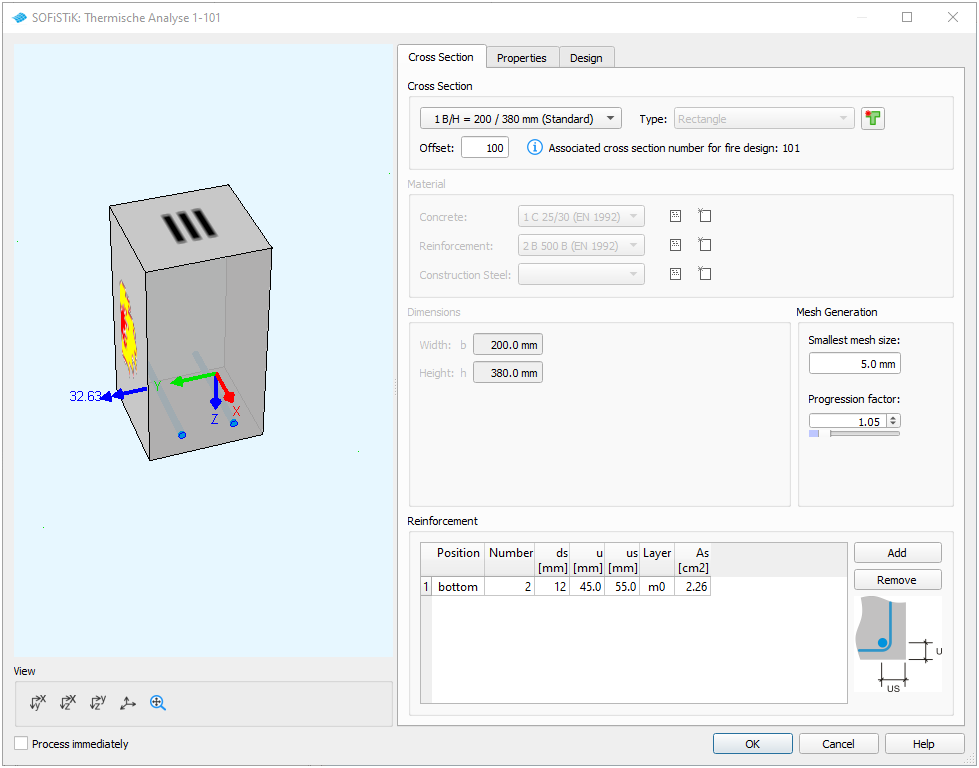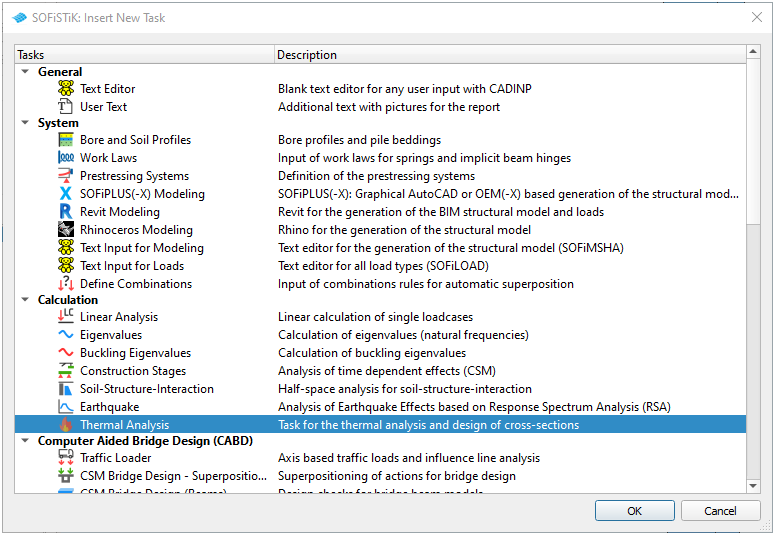Thermal Analysis#
Description#
This task allows for the thermal analysis and the subsequent design of an arbitrary cross section, by calculating the resistance values under fire conditions. In addition, it is possible to utilize the hot cross section for further (non-linear) analysis.
To achieve this goal, the temperature distribution within the cross section is calculated. Various fire curves and other constraints can be applied to the surfaces of the cross section.
For statically determined systems, this task allows the design of reinforced concrete components in the event of fire according to Eurocode DIN_EN_1992-1-2 [1].
User Interface#
The graphical user interface of the task Thermal Analysis consists of an interactive preview pane on the left and the input area on the right consisting of the following tabs:
The preview pane shows a 3D model of the cross section, including the reinforcement, and fire loading situation. Investigate the cross section from all sides by clicking-and-dragging inside the viewer and zoom with the mouse wheel, or use the predefined views in the bottom row.
In addition, the following general graphical user interface elements exist:
GUI Element |
Description |
|---|---|
|
Exit task and save input. Text Editor file gets updated. |
|
Determines if the task will be executed upon exiting the dialog or at a later time. |
|
Exit task without saving your input. Text Editor file does not get updated. |
|
Open this Online Documentation. |
Cross Section#
Select an existing cross section from the data base or generate a special cross section and prepare it for thermal analysis.

Cross Section#
Use the drop down menu to select an existing cross section from the data base or generate a special cross section with the right-most button. Define the special cross sections by choosing T-beam with variable web width or Composite Section of filled double-T-sections.
Set the cross section number of the resulting hot cross section by defining an offset.
Note
Cross sections created via SSD, SOFiPLUS and Teddy, as well as special cross sections by this task, are supported.
The type of cross section and how it was created determines the available settings to control its dimensions and precise location of reinforcement.
Material#
Review material properties for existing cross sections or define them for newly created special cross sections.
Dimensions#
Review cross section dimensions for existing cross sections or define them for newly created special cross sections.
Mesh Generation#
Influence mesh density by defining Smallest mesh size and Progression factor (only available for standard rectangle sections).
Reinforcement#
Define the precise location of the rebars. This is the most crucial step for the computation of the temperature distribution throughout the cross section and to determine the resulting strenght of the hot cross section for further analysis.
Properties#
Determines all settings related to the thermal analysis itself.
Fire Load#
Define the protection class or the duration for the cross section to withstand fire loading. Choose from the supported fire curves or select User defined.
Fire Action#
Define the fire exposure or symmetry conditions for each face of the cross section. Input can be graphically or via table, depending on the cross section type.
Note
If the box remains empty, the cross section is either unsuitable or not prepared properly for thermal analysis. For further information, please refer to Tutorials for Fire Design
Fire Curve#
Displays the selected fire curve both graphically and tabularly. Possibility to edit time step - temperature value pairs, depending on the fire curve type.
Material#
Set Heat Transmission, Thermal Conductivity and other Thermal Properties for the concrete.
Hint
Extended Material Values from a Property Set for a Modified Boundary in SOFiPLUS(-X) are not supported.
Design#
Allows the concise design of a cross section for a statically determined member by choosing design type, mode and forces. For other members, this tab can be disregarded.
Design Parameters#
Define Design Type, Design Mode and the allowable Maximum strain for compressure. To consider construction stages, it is possible to select the Activated Groups of a cross section.
Design Forces#
Define the design normal force and bending moments under fire for the cross section.
Step-by-Step Instructions#
Step 1: Add Task#

Step 2: Define Cross Section#
Option a: Standard cross section via SSD#
and choose among the available cross sections.
Please note that only the following cross section types are allowed:
Cross Section |
Restrictions |
|---|---|
|
None |
|
None |
|
Fire load placement limitation:
Can only be applied on all faces simultaneously. For more detailed fire loading, refer to Special Cross Sections.
|
|
Fire load placement limitation:
Circle divided in four quadrants. For more detailed fire loading, refer to Arbitrary Cross Sections.
|
|
Fire load placement limitation:
Only I-profile cross sections are supported. For other profiles, refer to Arbitrary Cross Sections.
|
Option b: Arbitrary cross section via SOFiPLUS#
and choose among the available cross sections
to initialize the Cross Section Editor by SOFiPLUS. Please note that such cross sections need to be manually prepared for thermal analysis to be used successfully.
See also
See Tutorials for Fire Design for a list of different scenarios, such as a hollow steel section or a coated steel section.
Option c: Special cross section via task Thermal Analysis#
Inside Thermal Analysis, click to define a new special cross section that doesn’t already exist in the data base.
Cross Section |
Details |
|---|---|
|
I-profile with reinforced concrete filling |
|
T-Beam section with variable web width |
Hint
Please note that only the resulting hot cross section can later be accessed outside the task.
Literature#
[1] Eurocode DIN EN 1992-1-2:2010-12 & DIN EN 1992-1-2/NA:2010-12